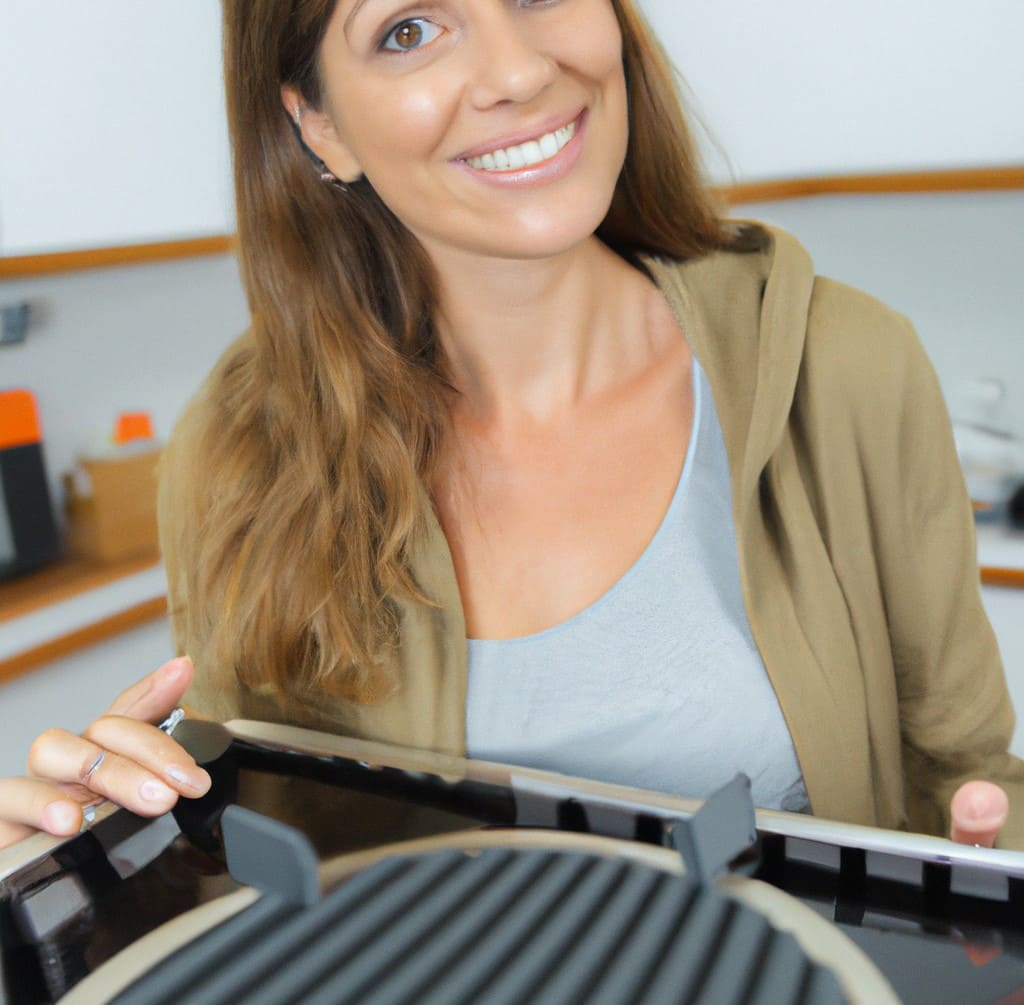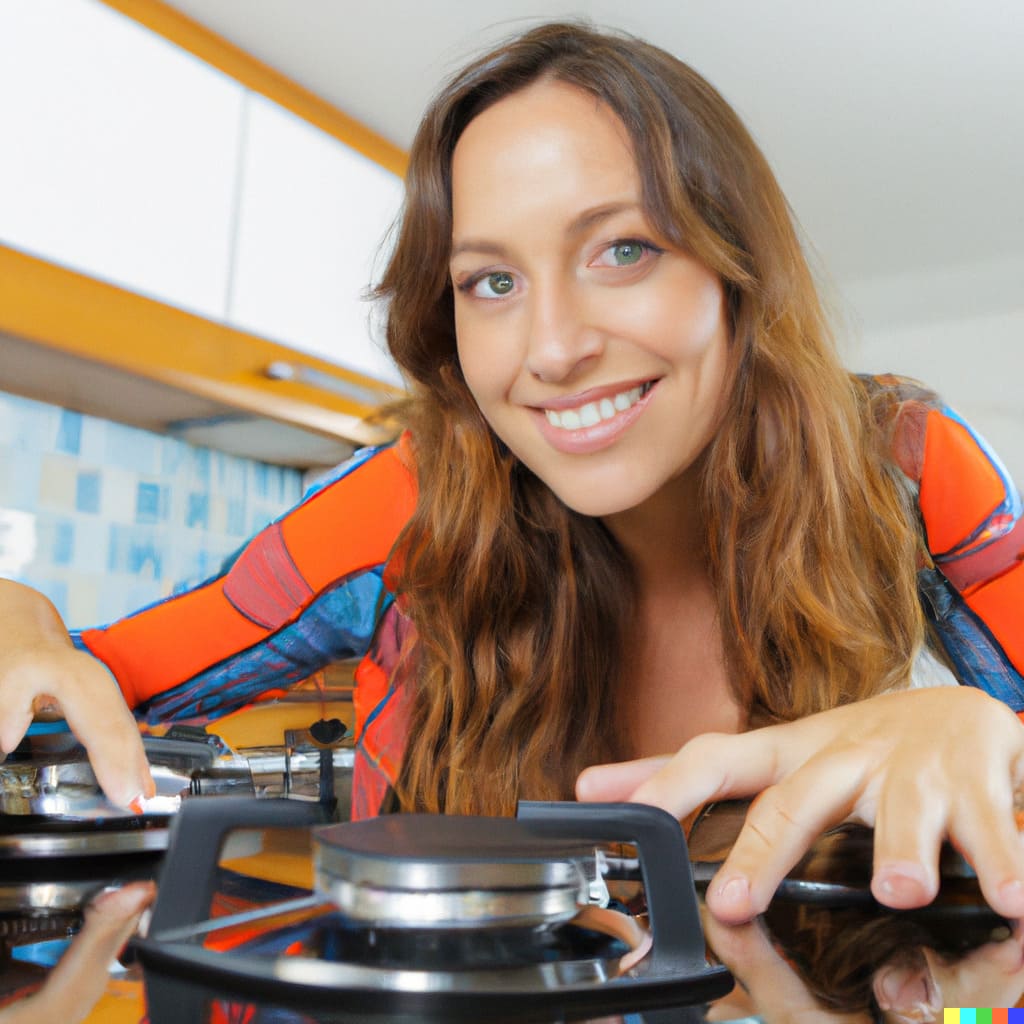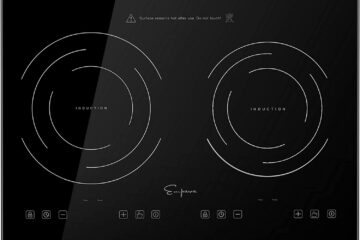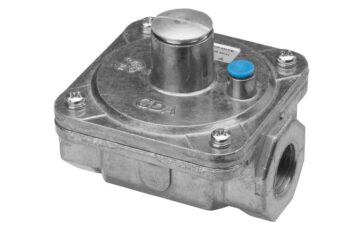Are you looking for an efficient and easy-to-use cooking appliance? A radiant cooktop might be just what you need. Radiant cooktops are a popular cooking option for many households, and a good reason. This type of cooktop offers a wide range of features that make it perfect for any kitchen.
So if you’re interested in learning more about radiant cooktops, in this blog post, we will explain everything you need to know about radiant cooktops so that you can make an informed decision about what type of cooktop is best for your home. Read on to learn all the details!
What Is An Induction Cooktop?
An induction cooktop is a stove or cooktop that uses induction heating to heat pots and pans. It uses an electromagnetic field to generate heat directly in the pot or pan rather than heat to warm the cooktop surface as with a gas or electric stove.
Because the heat is generated directly in the cookware, induction cooktops are often more energy efficient than other types of cooktops and can also provide faster heating and more precise temperature control. They also tend to be more expensive and require cookware made of certain materials, such as ferromagnetic metals, to work correctly.
What Is A Radiant Cooktop?
What does a radiant cooktop mean? A radiant cooktop, also known as a ceramic or glass cooktop, is a type of stovetop that uses radiant heat to cook food. This means that the heating element is located beneath the cooktop’s surface and heats up the cooking vessel directly rather than heating it.
The cooktop surface is typically made of glass or ceramic, which is smooth and easy to clean. The heating element is usually made of metal, such as stainless steel, and is controlled by knobs or touch controls. Some models may also include a built-in timer or automatic shut-off feature for added convenience and safety.

Radiant cooktops are becoming increasingly popular because of their sleek, modern design and efficient cooking performance. They also offer a safer alternative to traditional gas stovetops, as there is no open flame and no risk of gas leaks. Additionally, radiant cooktops are easy to clean, as spills and stains can be wiped away with a damp cloth or sponge.
The Types of Radiant Cooktops
There are several types of radiant cooktops available, including:
1. Electric radiant cooktops
Electric cooktops use electricity to power the heating elements and are typically the most common type of radiant cooktop. They are easy to use and can be controlled by knobs or touch controls.
2. Induction radiant cooktops
These cooktops use induction technology, which creates a magnetic field that heats the pot or pan directly rather than heating the cooktop surface. Induction cooktops are known for their fast heating and precise temperature control.
3. Dual-fuel radiant cooktops
These cooktops combine an electric radiant cooktop with a gas burner, offering the best of both worlds in terms of convenience and cooking performance.
4. Gas radiant cooktops
These cooktops use gas as a fuel source and typically have sealed burners to prevent spills and stains from getting inside.
5. Radiant Downdraft Cooktops
This cooktop is a combination of radiant cooktops and downdraft ventilation systems. This type of cooktop is designed to pull smoke and steam away from the cooking surface, making it a good choice for homeowners who want to keep the kitchen well-ventilated while cooking.
Difference Between Induction And Radiant Cooktop
The main difference between induction and radiant cooktops is how they generate heat.
Radiant cooktops use electric heating elements beneath the cooktop surface to heat the pot or pan directly. The cooktop surface does not get hot, and the heat is transferred through the base of the pot or pan. Radiant cooktops are typically less expensive than induction but can take longer to heat up and cool down.
On the other hand, induction cooktops use magnetic induction technology to create a magnetic field between the cooktop and the pot or pan. This causes the pot or pan to heat up directly rather than heating the cooktop surface. Induction cooktops are more expensive than radiant cooktops, but they are faster and more energy-efficient. They also tend to be more precise with temperature control, which means you can cook your food at a lower heat without the risk of burning it.
So, the main difference between induction and radiant cooktops is that Induction cooktops heat the pot or pan directly. In contrast, radiant cooktops heat the pot or pan through the cooktop surface. Induction cooktops are more expensive but more energy-efficient and precise. In contrast, Radiant cooktops are less expensive but take longer to heat up and cool down.
- Can You Use Aluminum Pans On Induction Cooktop?
- How To Unlock Wolf Induction Cooktop? (The Right Method)
Are Radiant Cooktops Good?
Radiant cooktops are an excellent option for sleek, modern design and efficient cooking performance. They are also safer than traditional gas stovetops as there is no open flame and no risk of gas leaks.
Additionally, they offer knobs or touch controls to adjust temperature and even a built-in timer or automatic shut-off feature for added convenience and safety.
What Is The Importance Of Having A Sharp Radiant Cooktop In The Kitchen?
A sharp radiant cooktop in the kitchen is essential for several reasons.
Firstly, a sharp cooktop can provide more efficient cooking performance. The heating elements are located beneath the cooktop surface, transferring heat directly to the pot or pan, allowing for faster and more precise cooking. This is especially useful when preparing delicate dishes that require precise temperature control.
Secondly, a sharp cooktop is often easier to clean and maintain. A radiant cooktop’s smooth, glass or ceramic surface is easy to wipe down and clean with a damp cloth or sponge. This can save time and effort, especially if you cook frequently.
Thirdly, a sharp cooktop can improve the overall appearance of your kitchen. Radiant cooktops are known for their sleek, modern design and can enhance the overall aesthetic of your kitchen. This is especially important if you want to renovate your kitchen or sell your home in the future.
Lastly, a sharp cooktop is generally safer than other cooktops as they don’t pose the risk of gas leaks like traditional gas stovetops. They also do not have open flames, reducing the fire hazard risk. This can give you peace of mind knowing that your kitchen is safer for your family and guests.
Is Radiant Cooktop The Same As Induction?
No, a radiant cooktop and an induction cooktop are not the same.
A radiant cooktop uses electric heating elements, usually made of coil or glass ceramic, to transfer heat to the cookware placed on top of the cooktop.
On the other hand, an induction cooktop uses electromagnetic energy to generate heat directly in the cookware, which then transfers the heat to the food. It uses a copper coil under the cooktop surface to create a magnetic field, which induces an electrical current in the iron in the cookware. This creates heat, which then cooks the food.
Induction cooktops are generally more energy efficient, responsive, and precise than radiant cooktops. Still, they require ferromagnetic cookware (such as cast iron or stainless steel with a magnetic bottom).
Radiant Cooktop Pros And Cons
Here are some of the pros and cons of radiant cooktops:
Pros:
Sleek, modern design: Radiant cooktops have a smooth glass or ceramic surface that is easy to clean and looks sleek and modern in the kitchen.
Safe: Radiant cooktops do not have an open flame and do not produce gas emissions, making them a safer option than traditional gas stovetops.
Easy to clean: Spills and stains can be easily wiped away with a damp cloth or sponge.
Energy-efficient: Radiant cooktops use electricity to power the heating elements, which can be more efficient than gas stovetops.
Cons:
Slow to heat up and cool down: Radiant cooktops take longer to heat up and cool down than gas stovetops.
Limited range of temperature: Some radiant cooktops may not reach high enough temperatures to accommodate some cooking techniques, such as high-heat searing.
Limited control: Some radiant cooktops may not be as precise with temperature control as induction or gas stovetops.
Specialized pots and pans: Specialized pots and pans are not required for radiant cooktops as opposed to induction cooktops.
Radiant Cooktop Vs. Smooth Top
A radiant cooktop is a type of stove that uses electric coils or ribbons to generate heat. The heating elements, typically glass or ceramic, are visible beneath the cooking surface.
On the other hand, a smooth top cooktop has a smooth, flat cooking surface made of glass or ceramic that is heated by electric elements hidden beneath the surface. They use radiant heat for cooking, it does not rely on heating coils exposed, and all the elements are under the ceramic or glass surface, which is visually more appealing.
What Is A Radiant Range?
A radiant range is a type of oven and cooktop combination appliance that uses radiant heat as the cooking method. The cooktop of a radiant range typically features electric heating elements, such as coil or glass ceramic heating elements, which transfer heat to the cookware placed on top of the cooktop. The oven portion of a radiant range uses radiant heat to cook food.
What Is A Radiant Electric Cooktop?
A radiant electric cooktop is an electric stovetop that utilizes radiant heat. Radiant heat, also called convection heat, is the process of moving hot air from one location to another, from the burner to the food being cooked on it.
Radiant cooktops are great for cooking meat and vegetables, making sauces and gravies, and baking loaves of bread and pastries. They can even be used for roasting whole chickens or turkeys!
What Is A Magnetic Induction Cooktop?
A magnetic induction cooktop is a stove that uses electromagnetic induction to heat pots and pans. An electromagnetic field is generated beneath the cooktop surface, which induces an electric current in the ferromagnetic metal of the cookware. This electric current, in turn, generates heat in the pot or pan, which is then transferred to the food.
What Is A Good Induction Cooktop?
The Havells Insta Cook PT 1600-Watt Induction Cooktop is a specific model of induction cooktop that has been well-reviewed by users for its performance and ease of use. It is one of the top options for consumers looking for a high-quality induction cooktop.
Does every home need a radiant cooktop?
A radiant cooktop is a type of stove that heats up quickly and evenly, making it a popular choice among many homeowners.
However, whether or not a home “needs” a radiant cooktop is a matter of personal preference and lifestyle. If you enjoy cooking and prefer a stove that heats up quickly, then a radiant cooktop might be a good choice.
On the other hand, if you don’t cook as often, or you’re OK with a stove that takes longer to heat up, then a radiant cooktop might not be necessary. It depends on your individual needs and preferences.
How To Choose A Radiant Cooktop For Your Home?
When choosing a radiant cooktop for your home, there are several factors to consider:
Size and Shape
One of the first things to consider when choosing a radiant cooktop is the size and shape of the cooktop itself. These cooktops come in various sizes and shapes, so it’s essential to measure the space in your kitchen where you plan to install the cooktop and find one that will fit. The shape of the cooktop is also essential, as you’ll want to ensure it matches the size and shape of your existing countertop or cabinets.
Number of Burners
Another essential factor to consider when choosing a radiant cooktop is the number of burners. Most cooktops come with four burners, but some models have more or less, depending on your needs. Consider how many burners you’ll need for your cooking style and how often you cook for a large group.
Cooking Features
Radiant cooktops also include various cooking features, such as temperature controls, timers, and self-cleaning options. Consider what features are important to you and your cooking style, and look for a cooktop with those features. Some cooktops also have a built-in exhaust fan, which can help eliminate smoke and odors from your cooking.
Safety Features
Safety is also an important consideration when choosing a radiant cooktop. Look for cooktops with safety features such as automatic shut-off, child-proof locks, and overheat protection.
Budget
Finally, consider your budget when choosing a radiant cooktop. Radiant cooktops come in a wide range of prices, so it’s essential to set a budget for yourself and look for a cooktop that fits your budget.
Tips For Using A Radiant Cooktop
Use the correct cookware: Radiant cooktops require flat cookware with a smooth bottom. Avoid warped or dented cookware as it can scratch the cooktop’s surface. Also, avoid using cookware made of aluminum or copper, as it can discolor the cooktop.
Use the correct burner size: Make sure to match the burner’s size with the cookware’s size. A small burner with a large pot will not heat efficiently and can cause food to burn.
Adjust the heat levels: Radiant cooktops have precise temperature controls that allow you to adjust the heat levels to your liking. Take the time to experiment with the different heat levels to find the perfect setting for your cooking.
Keep the cooktop clean: Radiant cooktops are easy to clean, but it’s essential to keep them clean to avoid scratches and stains. Use a damp cloth and a mild cleaner to wipe down the cooktop after each use.
Use a stove liner: To avoid scratches and stains, use a stove liner on your cooktop. This can protect the surface from spills and splatters and make cleaning easier.
Be mindful of the cooktop surface: Do not drop or drag heavy pots or pans on it, as it can scratch or damage the cooktop surface.
Allow the cooktop to cool down: Before cleaning or wiping the cooktop surface, make sure the cooktop has cooled down completely.
Follow the manufacturer’s instructions: Always read the instructions before using your radiant cooktop. They will have important information on properly using and maintaining your cooktop.
Final Words
There you have fun facts, tips, and tricks about radiant cooktops. There’s a lot to like about this cooking technology, including the control and the convenience. Radiant cooktops are a viable alternative to gas and electric stoves and are great for residential use.
Frequently Asked Questions
Can You Use Cast Iron On A Radiant Cooktop?
Yes, you can use cast iron on a radiant cooktop. However, it’s essential to ensure the pan’s bottom is flat and smooth to prevent scratching the cooktop’s surface. It’s also essential to use low to medium heat settings to prevent warping or cracking of the pan.
Do You Need Special Pans For Radiant Cooktops?
You don’t necessarily need special pans for radiant cooktops. Still, it’s essential to use flat and smooth pans on the bottom to prevent scratching the cooktop’s surface. Some types of cookware that work well on radiant cooktops include stainless steel, aluminum, and copper. Avoid using cookware with rough or uneven bottoms, such as cast iron pans that have not been appropriately seasoned, as it may scratch the cooktop surface.
How Much Is A Gaggenau Induction Cooktop?
On average, a basic Gaggenau induction cooktop can range from $2,000 to $3,500. More advanced models with additional features and larger sizes can cost upwards of $8,000. It also depends on the size of the cooktop. Prices can also vary depending on location and where you purchase the cooktop.



